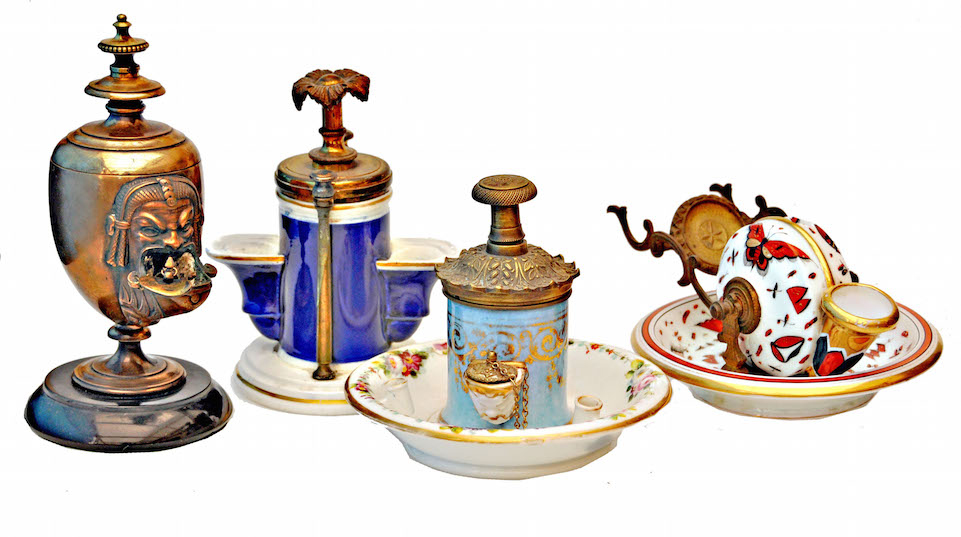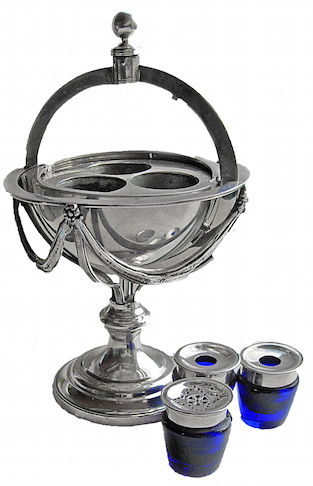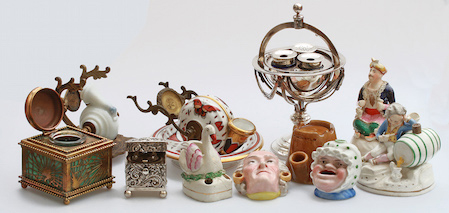
LONDON – When was the last time you wrote a letter? Indeed, when was the last time you actually stuck a stamp on an envelope and posted it? In these days of email, instant messaging and social media, putting ink on paper is so old school, to say nothing of the price of stamps these days. So why collect the paraphernalia associated with letter-writing? Speaking for myself, I think it’s the tangible link fountain pens, Eversharp pencils, inkwells and the other accoutrements of a bygone age conjure up to the individuals who used them.
Merseyside dealer Jim Marshall of the Pen & Pencil Gallery, is a kindred spirit. He’s published a definitive new book, titled Collecting Old Writing Equipment, which he will be promoting at the Northern Pen Show this Sunday, April 19. The book, limited to 300 copies, runs to almost as many pages and is crammed with a vast amount of information, including histories and practical guides to collecting. More than 150 pages are devoted to rare and exotic examples illustrated with pictures, many from Marshall’s personal collection, some of which will be on sale at the show. The book is being sold at a special fair price of £50 (usually £60), with all proceeds being donated to the charity Cumbria Cerebral Palsy.

One of Marshall’s earliest exhibits is a rare quill-cutting machine that dates from 1680. The death of both quill pens and the inkwell followed shortly after the appearance of the fountain pen, first mass-produced by Waterman in 1884, but inkwells have a history stretching much further back in history. Naturally enough, there have been inkwells as long as there has been ink and instruments to write with it. The earliest form was called an ink horn, probably made of a cow or ox horn, a material that was not just readily available, but was also the right shape and waterproof. Another early material was boiled leather, known as cuir bouilli, which unlike horn, needed a waterproof liner. However, being leather, it could be fashioned into many different shapes, and often decorated with fine toolwork depicting coats of arms, saints or hunting scenes. Inkstands, the name given to the usually decorative cruet-type holders for inkwells, are highly collectible, both for their ingenuity and their exotic designs, and have been made in just about every material imaginable, notably gold and silver.
A fine example of the latter is A Sheffield plate globe inkstand modeled as a globe, made in about 1800.

It has two wells and a sander with cobalt blue glass bodies.

By the late 19th century, many of the most famous ceramic manufacturers were producing magnificent inkstands, demonstrating great craftsmanship and flair. The important French maker Sèvres produced some stunning designs, which are now highly sought by enthusiasts. A particularly unusual inkstand operates by using an ingenious hydraulic system. An adjustable plunger, actuated by rotating a knob at the top of the inkstand, forces the ink held in a central reservoir into single or multiple fonts into which the user dips his quill. It was invented by a Monsieur Bouquet who worked for Sèvres and was patented in 1831 as “a mechanical inkwell that keeps the ink always clear and can be filled and emptied at will.”
Another French pump inkwell, the bronze body modeled with a grotesque mask, has an open mouth that serves as the well. It dates from about 1850.

The blue ceramic hydraulic inkstand illustrated at the start of this article was made in Birmingham by Joseph Schlesinger, who in 1842 patented an improvement that prevented the plunger turning as the knob was rotated. Clearly an industrious man, Schlesinger also patented designs for music stands and paper clips.
Ink containers that would not spill their contents were a natural progression as travel became possible and more popular. In the late 1700s, the so-called excise bottle, a simple spill-proof design utilizing an interior glass funnel appeared, named after the excise men who traveled the country collecting the duty imposed by the Treasury. Traveling inkwells can be found in a huge variety of forms, particularly when the ingenuity of the Victorians was brought to bear on their design and manufacture and many survive today. One of the neatest designs was by De La Rue, the manufacturer of high quality fountain pens and paper, which pivots and forms its own stable base. In addition to the beautiful and the ingenious, inkwells were also made to novelty designs, which among other things can be found fashioned as top hats and umbrellas, buckets and spades, musical instruments and even the busts of eminent personages.
An example is this inkwell modeled as a seated brown bear. His head lifts off to get to the ink.

With the introduction of steel nibs, pens could no longer be stored point down, for fear of damaging the irreparable nibs, hence the appearance of pen rests, which is another area of interest for the collector. There are also fascinating objects, called penners, which are containers filled with the various tools required by a scribe. These could include a pen or quill knife, quills, a pencil, pounce pot, wafer box and seal and any other tools devised with ingenuity to meet the needs of the writer. The pounce pot, or sander, was used to scatter powdered sandarac – the gum of the Moroccan sandarac tree, a type of conifer – cuttlefish bone or resinous gums, to either prepare the surface of coarse paper for writing or to blot wet ink.
Pounce pots are often mistaken for pepper pots, their true identity revealed by their concave, sunken tops rather than rounded as with a pepper pot, which allowed surplus powder to be tipped back and saved.
Specialist dealers and collectors gather at fairs devoted to writing tools and associated antiques around the country. The Northern Pen Show, is at the Doubletree Hilton Hotel in Hoole, Chester. Others include the North East Pen Show at the Copthorne Hotel, Quayside, Newcastle upon Tyne on Sunday, May 10, and the Midlands Pen Show at The Guildhall, Lichfield on Sunday, June 21. Jim Marshall will also be exhibiting at what the organizers claim to be the largest pen show in the world: the Washington, D.C. Collectible Fountain Pen Supershow on Aug. 13-16.
Inkwells can be found at all price levels. Among the most affordable and the naïve and charming examples made by Staffordshire potters such as the swan, face mask, crying baby and topers, the ink being stored in their barrel.




